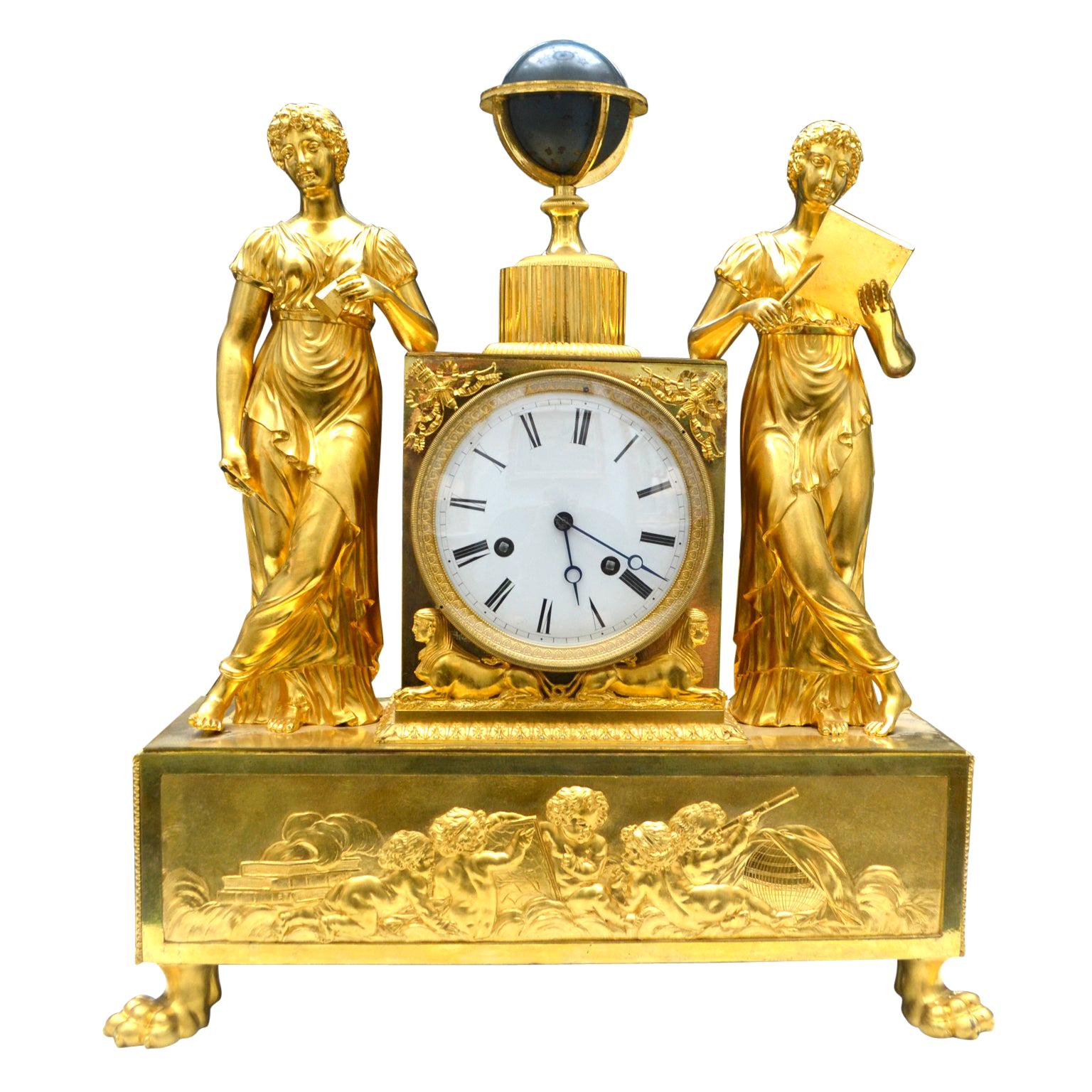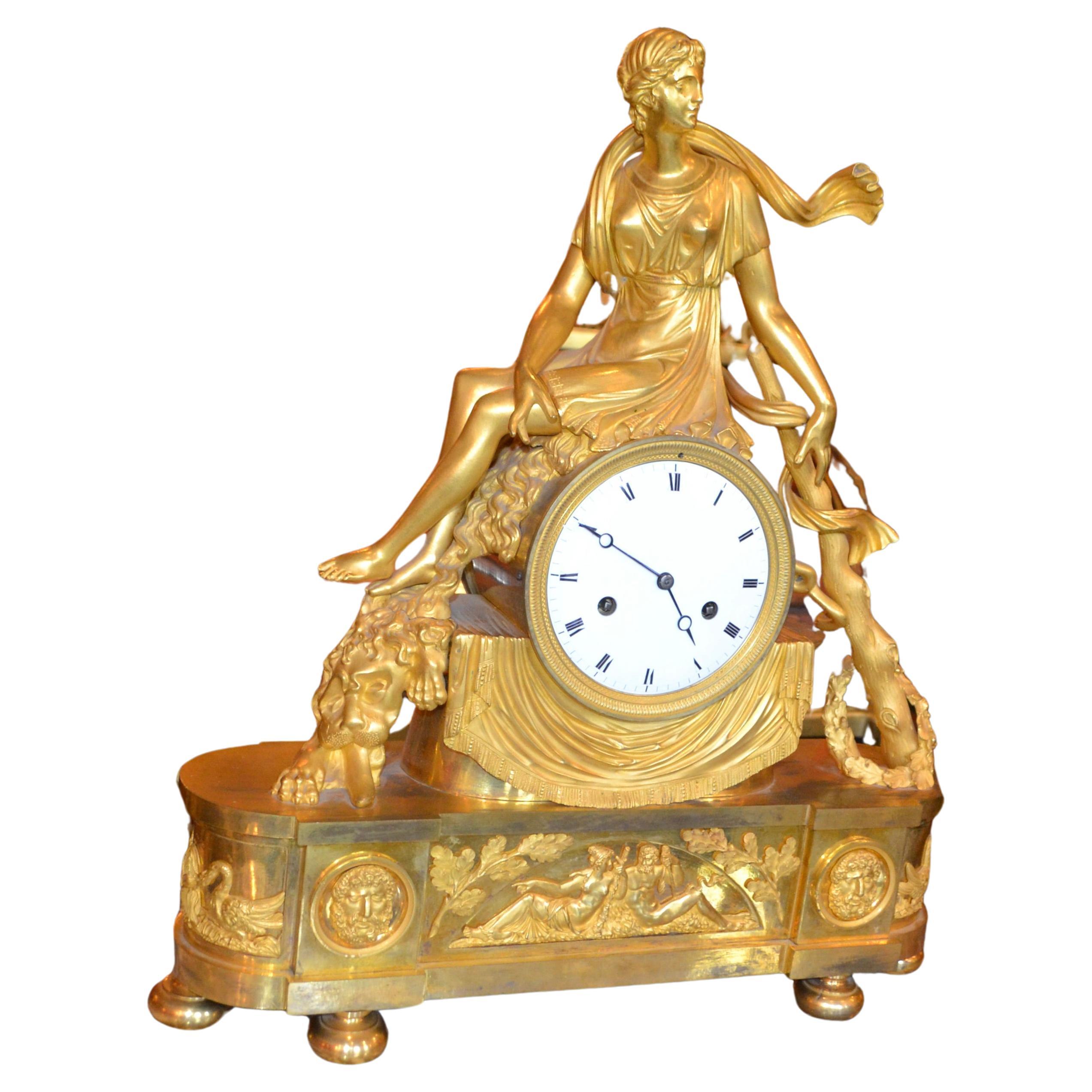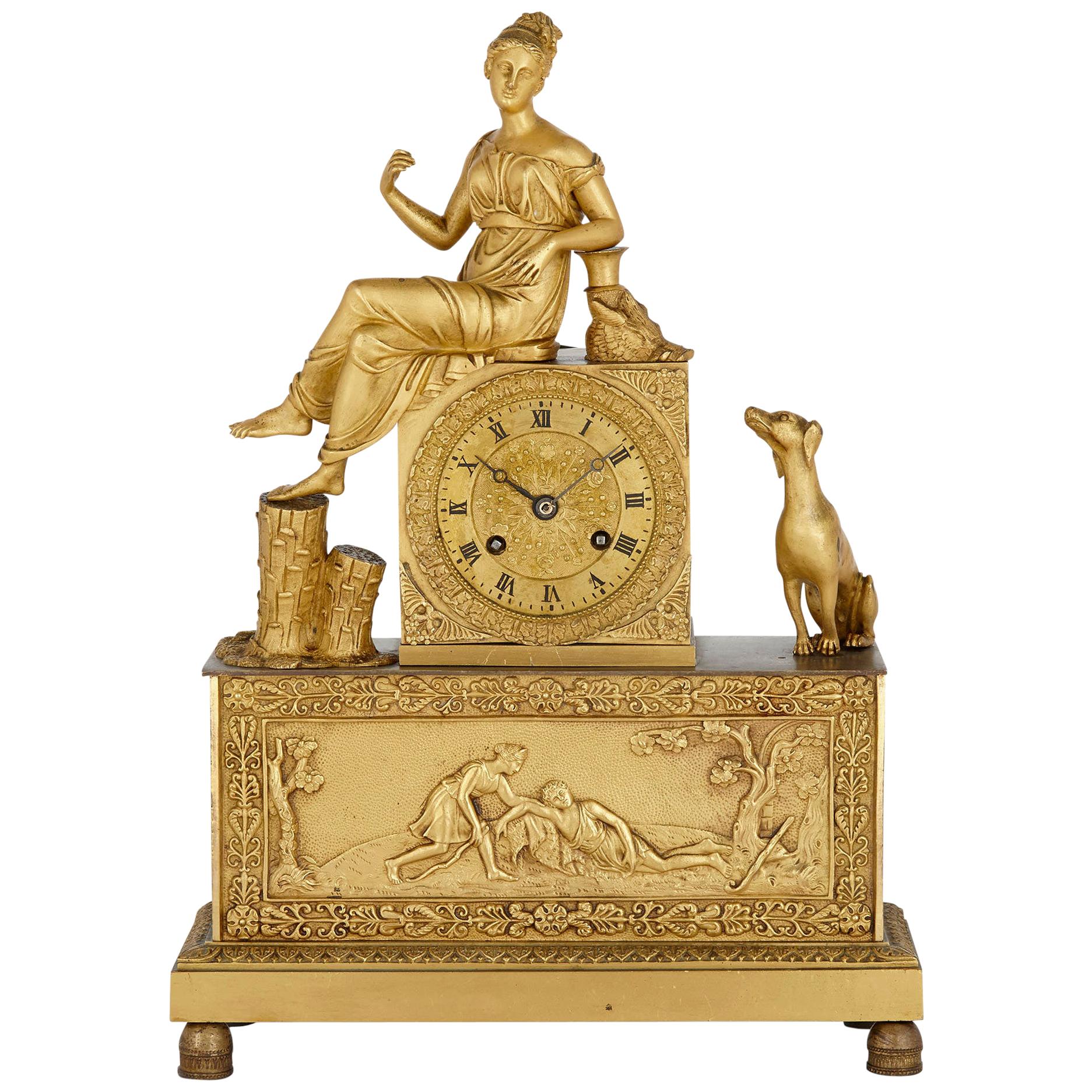Items Similar to Empire Gilt-Bronze Clock Depicting Diana the Huntress. French, c 1820
Want more images or videos?
Request additional images or videos from the seller
1 of 6
Empire Gilt-Bronze Clock Depicting Diana the Huntress. French, c 1820
About the Item
A fine Empire Period gilt bronze clock depicting Diana the huntress.
The dial signed 'Thomas a Paris'.
The white enamel dial with Roman numerals and Breguet hands, the case surmounted by a figure of Diana, with her dog at her side and quiver over her shoulder. The base is adorned on three sides with hunting attributes, above a palmette frieze and raised on four lions paw feet.
French, circa 1820.
- Dimensions:Height: 21.66 in (55 cm)Width: 16.54 in (42 cm)Depth: 7.09 in (18 cm)
- Style:Empire (Of the Period)
- Materials and Techniques:
- Place of Origin:
- Period:
- Date of Manufacture:circa 1820
- Condition:Wear consistent with age and use.
- Seller Location:Brighton, GB
- Reference Number:
About the Seller
5.0
Recognized Seller
These prestigious sellers are industry leaders and represent the highest echelon for item quality and design.
Platinum Seller
These expertly vetted sellers are 1stDibs' most experienced sellers and are rated highest by our customers.
Established in 1964
1stDibs seller since 2014
48 sales on 1stDibs
Typical response time: 1 hour
Associations
The British Antique Dealers' AssociationLAPADA - The Association of Arts & Antiques Dealers
- ShippingRetrieving quote...Ships From: Brighton, United Kingdom
- Return PolicyA return for this item may be initiated within 7 days of delivery.
More From This SellerView All
- Napoléon III Gilt-Bronze Double-Faced Clock. French, c 1870By Julien Le RoyLocated in Brighton, West SussexA rare Napoléon III gilt bronze double-faced clock. The white enameled dial signed 'Julien Le Roy A PARIS'. This rare Rococo style figural clock h...Category
Antique Late 19th Century French Napoleon III Table Clocks and Desk Clocks
MaterialsBronze
- Empire Clock in the Form of a Classical Urn, by Maison Lepautre, circa 1825By Pierre-Basile LepauteLocated in Brighton, West SussexA gilt bronze Empire clock in the form of a classical urn, by Maison Lepautre. French, circa 1825. The dial signed 'Lepaute a Paris'. The clock has an ornate cast bezel with a 3-inch porcelain dial with Roman numerals and Breguet style hands. The twin train eight-day movement with outside count wheel striking on a bell and silk thread suspension. This elegant Empire style clock has a gilt bronze case in the form of a classical urn with swan neck handles and a winged cherub to the neck. The circular pedestal base is raised on a footed stepped square plinth. The Lepaute family were the premier French clockmakers of their day. Their significance lies in their contribution to the clock making industry which had hitherto come under the trade of locksmiths. The family held the brevet Horlogers du Roi. Jean-André Lepaute (1720–1789) arrived in Paris at an early age and in 1740 founded the family business. A skilled artist and mechanic, he quickly gained an excellent reputation. He was received as maître by the clockmakers guild in 1759, was granted royal lodgings from the king in The Luxembourg Palace, and was entrusted with the construction of the majority of the great public clocks of Paris. He executed, amongst others, those in The Luxembourg Palace, the Jardin des Plantes, the Château de Bellevue and the Château des Ternes. His clock at Paris’s École Militaire still works today. Three editions of his Traité d’Horlogerie were published in Paris in 1755, 1760 and 1767. A small volume, Description de Plusieurs Ouvrages d’Horlogerie appeared in 1764. Jean-André’s wife, Nicole-Reine Etable de la Brière (1723-1788), was a highly esteemed mathematician and astronomer. Her passion for science lent itself to Lepaute’s work and she played an active role in the scientific and mathematical aspects of the clock making. Jean-André’s younger brother Jean-Baptiste Lepaute (1727-1802) joined him in Paris in 1747 and immediately started working for the family business. He was received as maître in 1776 and was known for the clocks he constructed for the Paris Hôtel de Ville (1780), destroyed in a fire of 1871, and for the Hôtel des Invalides (1784). Jean-Baptiste took over the workshop when Jean-André retired in 1775. After Jean-Baptiste’s death in 1802, the firm was taken over by his nephew Pierre-Basil Lepaute (1750-1843) where he was duly joined by his own nephew Jean-Joseph (1768-1846) and son Pierre-Michel (1785-1849). By 1816, Pierre-Michel Lepaute was in charge of the business. His masterpieces include the astronomical clock in Paris’s Bureau...Category
Antique Early 19th Century French Empire Mantel Clocks
MaterialsBronze
- Charles X Gilt and Patinated Bronze Figural Mantel ClockLocated in Brighton, West SussexThe dial signed 'Ritter Aîné à Rouen', The case surmounted by a seated figure of Mars holding a scroll marked 'Marathon', seated on a cushioned throne with lion-paw feet, below hi...Category
Antique 19th Century French Charles X Mantel Clocks
MaterialsBronze
- Chinoiserie Style Gilt-Bronze and Enamel Figural ClockLocated in Brighton, West SussexA rare Chinoiserie style gilt-bronze and enamel figural clock. This elegant and sophisticated clock has a finely chiselled gilt-bronze case with gold and enamel highlights. It dep...Category
Antique 19th Century French Chinoiserie Mantel Clocks
MaterialsOrmolu
- Fine Gilt-Bronze and Champlevé Enamel Clock, circa 1880Located in Brighton, West SussexA fine gilt bronze and champlevé enamel clock. French, circa 1880. The movement with impressed stamp to the backplate 'Vincenti et Cie 'Médaille D'Argent 1855', 'PARIS'. Thi...Category
Antique Late 19th Century French Mantel Clocks
MaterialsBronze, Enamel
- Louis XVI Style Gilt-Bronze Cartel Clock, by BeurdeleyBy Alfred Emmanuel Louis BeurdeleyLocated in Brighton, West SussexA fine Louis XVI style gilt-bronze Cartel clock, by Beurdeley. Signed 'A Beurdeley Fils à Paris'. Surmounted by a ribbon tied globe the gilt-bronze case of this fine cartel cl...Category
Antique 19th Century French Louis XVI Wall Clocks
MaterialsOrmolu
You May Also Like
- French Empire Gilt Bronze Allegorical Clock Depicting the Astronomical SciencesLocated in Vancouver, British ColumbiaA fine early 19th century French Empire gilt bronze clock representing an allegory of astronomy; featuring two classically draped maide...Category
Antique Early 19th Century French Empire Mantel Clocks
MaterialsBronze
- French Empire Gilt Bronze Clock Depicting the Lydian Queen OmphaleLocated in Vancouver, British ColumbiaAn early 19 century French Empire gilt bronze clock depicting the mythological Lydian Queen Omphale sitting astride on a draped drum th...Category
Antique Early 19th Century French Empire Mantel Clocks
MaterialsBronze
- French Empire Gilt Bronze ClockLocated in London, GBFrench Empire gilt bronze clock French, early 19th century Measures: Height 38cm, width 27cm, depth 10cm This fine gilt bronze man...Category
Antique Early 19th Century French Empire Mantel Clocks
MaterialsBronze, Ormolu
- French Fire-Gilt Bronze Clock Depicting Troubadour Figures c. 1820Located in 263-0031, JPA French fire-gilt clock depicting a standing pair of figures in “troubadour” attire, Restauration Era, 1815-1830. The silk-thread mechanism is in good working condition with key and...Category
Antique Early 19th Century French Restauration Table Clocks and Desk Clocks
MaterialsBronze
- Allegorical French Empire Gilt Bronze Clock Depicting Earth’s Source of WaterLocated in Vancouver, British ColumbiaA gilt bronze French Empire clock depicting an allegory to the earth’s water source. In this clock a classically draped nymph sits atop a rocky outcrop her right foot resting on the ...Category
Antique Early 19th Century French Empire Mantel Clocks
MaterialsBronze
- A French Antique Empire Gilt Bronze Silk Thread Mantel Clock, Circa 1820Located in Los Angeles, CAA French Antique Empire Gilt Bronze Silk Thread Mantel Clock The neoclassical theme with a lady and a mandolin.The clock retains its original blued steel Breguet style hands. The ...Category
Antique 1820s French Empire Mantel Clocks
MaterialsBronze
Recently Viewed
View AllMore Ways To Browse
Empire Gilt
Empire Gilt Bronze
19th C Empire
Empire Clock France
A French Empire Clock
Empire Bronze Clock
French Empire Bronze Clock
French Figural Bronze Clock
Breguet Numerals
Gilt Empire Clock
Figural Gilt Clock
Bronze Lion Empire
Mantel Lion
Frieze Roman
Empire Gilt Bronze Clock
French Empire Gilt Bronze Clock
French Bronze Clock Depicting
French Gilt Figural Clock





